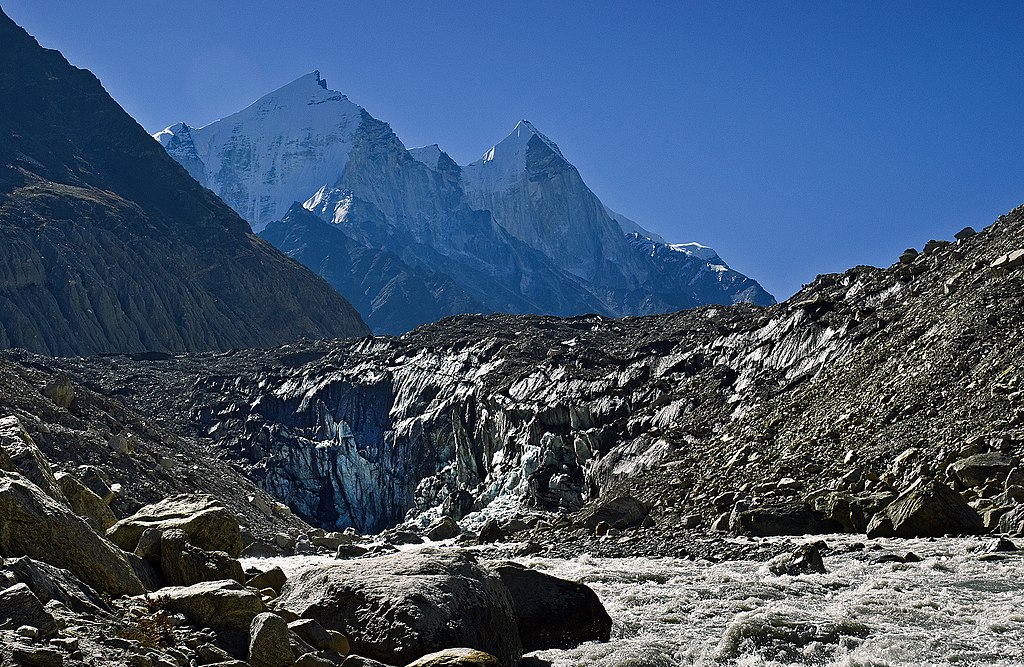Featured image: The terminus of the debris-covered Gangotri glacier. CC BY-SA 4.0, via Wikimedia commons
Article : Accelerated mass loss of Himalayan glaciers since the Little Ice Age
Authors : Ethan Lee, Jonathan L. Carrivick, Duncan J.Quincey, Simon J. Cook, William H. M. James, Lee H. Brown
The health of Himalayan glaciers is deteriorating at an alarming rate. These Himalayan ‘water towers’ are on the brink of undergoing irreversible changes due to climate change, which in turn will have an adverse effect on the water and food security of South Asia. Getting a good idea of what might happen to these glaciers is imperative, but until now, glaciologists have focused on recent fluctuation patterns of these glaciers spanning the past few decades. In a new study, Lee and colleagues tried to reconstruct the glacial surface of some 14,798 Himalayan glaciers during the Little Ice Age and found that compared to other non-polar regions, Himalayan glaciers might be even more sensitive to fluctuations in the climate.
The Little Ice Age witnessed the last expansion of glaciers in the Himalayas. Using palaeo-surface reconstruction method and glacial moraine mapping, Lee and his colleagues found that Himalayan glaciers have lost a staggering 40% of the total area they covered during the peak of Little Ice Age glaciation. The trends of ice loss post Little Ice Age in the study areas of Spiti, Lahaul, East and West Nepal, Bhutan were very different. Glaciers in the Eastern Himalayas lost ice at a rate far faster than ones in Western Himalayas, plausible reason being that, the Eastern Himalayas are more sensitive to temperature and climate variations. This trend continues even today. Such a disproportionate response is very concerning.
Debris cover controls the reaction of the glacier to temperature changes and the amount of sunlight. It’s like a blanket. The thicker the debris cover, the more insulation it provides. If we go by this logic, debris-covered glaciers should lose less ice compared to clean glaciers. But the findings show otherwise. Supraglacial debris promotes ponding of melt water on the surface, and facilitates the transfer of heat at the glacier-debris interface. More than 20% of Himalayan glaciers are debris-covered. Hence, it makes sense for them to significantly contribute to the ice mass loss.
Formation of glacial lakes is making things worse. Glacial lakes are natural meltwater lakes formed at the snout, on the surface, along the periphery, at the base or inside a glacier. Ponded meltwater amplifies melting of glacial ice. The number of Himalayan glacial lakes has shot up by 110% since 1964. The incidents of glacial lake outburst floods due to failure of moraine dams have increased in the recent past. These floods are a serious threat to the lives of people living in the valleys.

Wikimedia Commons
The findings made by Lee and his colleagues are interesting and worrying at the same time. The glaciers are struggling to keep up with the changing climate and have lost their resilience. The Himalayan cryosphere is becoming unstable day by day. Hence, it’s necessary to take action with urgency in order to safeguard human lives and prevent future catastophes.
The third pole is in peril ! by Amber Saraf is licensed under a Creative Commons Attribution-ShareAlike 4.0 International License.

